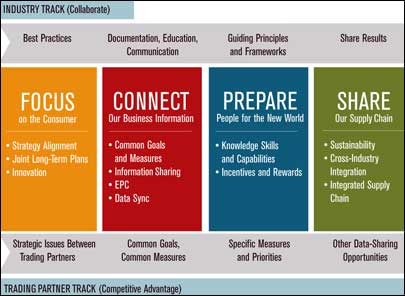At EPC Connection 2008, EPCglobal North America‘s fifth annual conference and exhibition held in October, I hosted a “New Ways of Working Together” panel discussion, based on a retail/consumer packaged-goods industry initiative started by Wegmans Food Markets and The J.M. Smucker Co. The initiative—built on a set of best practices—introduces a strategic framework for trading partners to use to enhance collaboration. It enables retailers and manufacturers to focus on agreed-upon plans while working together to eliminate supply-chain disruptions and jointly grow their businesses.
What does this have to do with radio frequency identification? Plenty. Electronic Product Code, data synchronization and other standards enable supply-chain partners to collaborate, not just in the retail/consumer packaged goods industry but in other sectors as well.

The panelists were Ann Dozier, VP of collaborative customer capabilities for North America retail sales at Coca-Cola; Mark Pollock, director of global EPC RFID initiatives at Kraft Foods; and Milan Turk Jr., managing director of global customer e-collaboration at Procter & Gamble.
Turk said Procter & Gamble sees the use of RFID based on EPC standards as part of the broader initiatives undertaken under the New Ways of Working Together umbrella. In other words, EPC RFID is not the be-all and end-all of collaboration; it’s one tool that helps facilitate collaboration.
It’s encouraging to see that EPC RFID is now being brought under larger enterprise initiatives, because that means there is a framework for deploying the technology where and when it makes sense. Dozier said some collaboration under the New Ways of Working Together framework might start with bar codes and migrate to EPC RFID as the technology matures and the applications become more apparent.
The framework calls for companies to:
• Select trading partners to work with
• Develop teams to align resources
• Prioritize strategic choices by aligning strategies
• Conduct joint business planning
• Develop common goals and measures in order to jointly track progress
Typically, a retailer assigns a buyer, a CPG company assigns a salesperson, and they work together. The buyer and the salesperson work with their own merchandising, marketing and logistics teams to ensure that goods are replenished, promotions are executed properly and so on.
The New Ways of Working Together framework calls for the retailer and supplier to bring together their IT, distribution, logistics, sales, accounting and marketing representatives to work directly with each other to facilitate commerce. This could enhance the adoption of EPC RFID, because it would essentially become a tool for executing strategies developed by these teams. If EPC RFID enables successful collaboration, then it will be applied more proactively by suppliers and retailers, and not be seen as something that simply benefits the retailer.
EPC RFID has been applied mainly to improving replenishment, reducing out-of-stocks and improving execution of promotional campaigns. New Ways of Working Together takes a more holistic approach. Sales teams from the partners work together to improve sales forecasts, sales growth, gross margins of items and gross-profit margins. Representatives from both logistics teams work together to reduce out-of-stocks, and also to improve on-time delivery and reduce order-to-delivery cycle times, unsalable goods and finished-goods inventory. Accounting teams could work together to improve invoice accuracy and on-time payments, while the IT teams could improve data synchronization and the accuracy of master data (information about each product).
EPC RFID could play a role in each of these areas. It might not have an impact immediately, but it’s likely that as these teams work together, they will find new ways of using EPC RFID, such as tagging only a few cases in each shipment to monitor their movement through the supply chain and identify bottlenecks, or using reads to confirm that goods ordered actually arrived and should be invoiced. These applications will make it easier for fast followers to adopt EPC RFID in the future.

